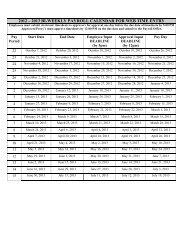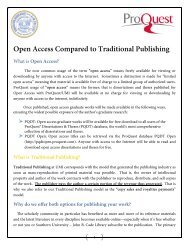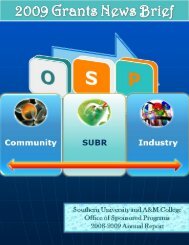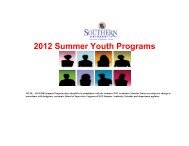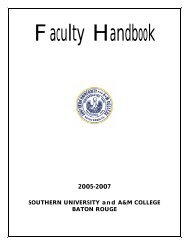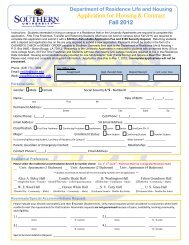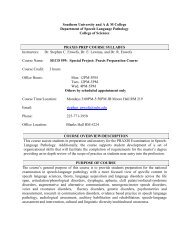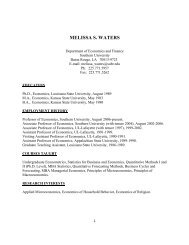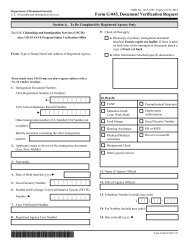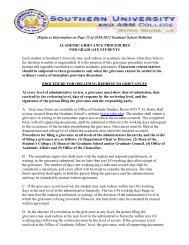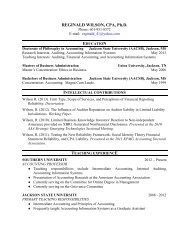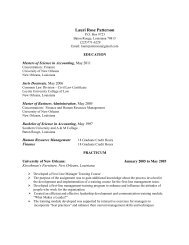MATH 395 Calculus III and Differential Equations for Jr. Engineering ...
MATH 395 Calculus III and Differential Equations for Jr. Engineering ...
MATH 395 Calculus III and Differential Equations for Jr. Engineering ...
Create successful ePaper yourself
Turn your PDF publications into a flip-book with our unique Google optimized e-Paper software.
SOUTHERN UNIVERSITY <strong>and</strong> A&M COLLEGE<br />
DEPARTMENT OF <strong>MATH</strong>EMATICS<br />
<strong>MATH</strong> <strong>395</strong><br />
CALCULUS <strong>III</strong> AND DIFFERENTIAL EQUATIONS FOR<br />
JUNIOR ENGINEERING MAJORS<br />
COURSE DESCRIPTION: This course combines selective topics normally covered in both<br />
calculus <strong>III</strong> <strong>and</strong> differential equations courses. Major focus is on application of fundamental<br />
mathematical pribnciples to investigate realistic design elements. Topics include: vector<br />
differential <strong>and</strong> integral calculus; power series (Bessel <strong>and</strong> Legendre functions, <strong>and</strong> Fourier<br />
Series), partial fractions, Fourier <strong>and</strong> LaPlace Trans<strong>for</strong>ms of derivatives, modeling <strong>and</strong> solutions<br />
to differential equations with real coefficients, initial value problems, free <strong>and</strong> <strong>for</strong>ced<br />
oscillations.<br />
INSTRUCTOR’S EMPHASIS: The course aims to foster genuine knowledge of course<br />
content, the development of key concepts, <strong>and</strong> the ability to think critically <strong>and</strong> solve problems.<br />
This course should be taken after the normal calculus II. Hence a purpose of the course is to<br />
extend the students’ knowledge of the <strong>Calculus</strong> by introducing them to additional topics in<br />
mathematics, which make use of the concepts, learned in calculus. The instructor will emphasis<br />
problem solving, critical thinking <strong>and</strong> communicating, both writing <strong>and</strong> orally. In addition, the<br />
instructor will emphasis solutions to problems numerically, algebraically, graphically <strong>and</strong> several<br />
applications The instructor will also provide the students with essential concepts <strong>and</strong> skills in<br />
differential equations which is needed to successfully complete their studies in engineering.<br />
INTENDED AUDIENCE: This course is designed <strong>for</strong> students in engineering at the junior<br />
level.<br />
CREDIT HOURS: 4.0<br />
PREREQUISITES: Mathematics 265 with a grade of “C” or better <strong>and</strong> junior st<strong>and</strong>ing in<br />
engineering are required prerequisites <strong>for</strong> this course<br />
TEXTBOOK: A First Course In <strong>Differential</strong> Equation (The Classical Edition), by<br />
Dennis G. Zill, Seventh Edition.
GENERAL GOALS:<br />
1. To provide the student with the skills to use logical <strong>and</strong> critical thinking<br />
<strong>and</strong> computational skills to master the course content.<br />
2. To provide the student with the skills necessary to give an explanation<br />
both orally <strong>and</strong> in writing of concepts in differential equations<br />
3. To provide the student with critical problem solving skills.<br />
4. To provide the student with concepts of differential equations that may<br />
be used in other areas of the sciences <strong>and</strong> engineering.<br />
LEARNING OUTCOMES:<br />
Upon completion this course, the student will:<br />
1. define <strong>and</strong> give examples of terms relative to the course content.<br />
2. recall <strong>and</strong> use <strong>for</strong>mulas from integral <strong>and</strong> differential calculus.<br />
3. draw figures to illustrate the meaning of the definition or theorem.<br />
4. compute multiple integrals.<br />
5. explain <strong>and</strong> give examples of theorems.<br />
6. apply Taylor’s Theorem, First <strong>and</strong> Second Shifting Theorem, to evaluate<br />
LaPlace Trans<strong>for</strong>ms, Bessel <strong>and</strong> Legrendre functions <strong>and</strong> Fourier Series.<br />
7. apply differential <strong>Equations</strong> to solve problems involving mechanical systems,<br />
electrical systems <strong>and</strong> changes relative to Newton’s First <strong>and</strong> Second Law of<br />
cooling.<br />
8. solve <strong>and</strong> present specific problems from the text under the supervision of the<br />
professor.
ASSESSMENT MEASURES:<br />
A. Instructor will create examinations, quizzes <strong>and</strong> homework.<br />
A. The student will solve problems on the board with the help <strong>and</strong> supervision of<br />
the instructor.<br />
COURSE CONTENT:<br />
Chapter 1. Introduction to <strong>Differential</strong> <strong>Equations</strong><br />
1.1 Definitions <strong>and</strong> Terminology<br />
1.2 Initial - Value Problem<br />
1.3 <strong>Differential</strong> <strong>Equations</strong> <strong>and</strong> Mathematical Models<br />
Chapter 2. First - Order differential <strong>Equations</strong><br />
2.1 Separable Variables<br />
2.2 Linear <strong>Differential</strong> <strong>Equations</strong><br />
2.3 Exact <strong>Differential</strong> <strong>Equations</strong><br />
2.3 Solution by Substitutions<br />
2.5 Some Numerical Solutions<br />
Chapter 3. Modeling With First Order <strong>Differential</strong> <strong>Equations</strong><br />
3.1 Linear <strong>Differential</strong> <strong>Equations</strong><br />
3.2 Nonlinear <strong>Differential</strong> <strong>Equations</strong><br />
Chapter 4. Higher Order <strong>Differential</strong> equations<br />
4.1 Some Preliminary Theory as Needed<br />
4.2 Initial Value <strong>and</strong> Boundary Value Problems<br />
4.3 Homogeneous <strong>and</strong> Non-homogeneous <strong>Differential</strong> <strong>Equations</strong><br />
4.4 Homogeneous <strong>Differential</strong> <strong>Equations</strong> with Constant Coefficients<br />
4.5 Undetermined Coefficients<br />
4.6 Variation of Parameters<br />
4.7 Cauchy - Euler <strong>Differential</strong> equations
Chapter 5. Mathematical Modeling With Higher Order <strong>Differential</strong> <strong>Equations</strong><br />
5.1 Linear <strong>Differential</strong> <strong>Equations</strong> <strong>and</strong> Initial Value Problems<br />
5.2 Free Undamped Motion<br />
5.3 Free Damped Motion<br />
5.4 Series Circuit Analogue<br />
5.5 Linear <strong>Differential</strong> <strong>Equations</strong> <strong>and</strong> Boundary Value Problems<br />
5.6 Nonlinear <strong>Differential</strong> equations<br />
Chapter 6. Series Solutions of Linear <strong>Differential</strong> equations<br />
6.1 Solutions About Ordinary Points<br />
6.2 Solutions About Singular Points<br />
6.3 Review Several Special <strong>Differential</strong> <strong>Equations</strong> (Optional)<br />
Chapter 7. The Laplace Trans<strong>for</strong>m<br />
7.1 Review <strong>and</strong> Solve problems by The Definition<br />
7.2 Inverse Laplace Trans<strong>for</strong>m <strong>and</strong> Laplace Trans<strong>for</strong>m of Derivatives<br />
7.3 Translation Theorems<br />
7.4 Some Additional Operational Properties (Optional)<br />
Chapter 8. System of Linear First Order <strong>Differential</strong> <strong>Equations</strong><br />
8.1 Some Preliminary Theory as needed<br />
8.2 Homogeneous Linear Systems with Constant Coefficients<br />
8.3 Distant Real Eigenvalues<br />
8.4 Repeated Real Eigenvalue<br />
8.5 Complex Eigenvalues<br />
8.6 Eigenvectors<br />
8.7 Variation of Parameters <strong>for</strong> System of <strong>Differential</strong> <strong>Equations</strong><br />
Chapter 9. Numerical Solutions of Ordinary <strong>Differential</strong> <strong>Equations</strong><br />
9.1 Bessel’s equations <strong>and</strong> Legendre functions<br />
9.2 Fourier Series<br />
9.3 Taylor’s Series
COURSE EXPECTATIONS AND STUDENT SUPPLEMENTS:<br />
1. EXPECTATIONS<br />
Students are expected to have the skills prerequisite <strong>for</strong> the course.<br />
2. THE <strong>MATH</strong>EMATICS LABORATORY (<strong>MATH</strong> LAB)<br />
The mathematics will be used to solve differential using the program “Joy<br />
of Mathematics”.<br />
3. OTHER RESOURCES<br />
a) Free individual tutoring in the Math Lab Room 318 T.T. Allain Hall.<br />
b) Individual help by the professor during the office hours<br />
4. CLASS ATTENDANCE<br />
Regular <strong>and</strong> punctual attendance is expected. Excessive absences <strong>and</strong> tardiness<br />
will not be tolerated. The student is responsible <strong>for</strong> keeping up with course<br />
work, whether or not an absence is excused. When a student receives FOUR or<br />
more absences, his/her academic st<strong>and</strong>ing in the course may be compromised,<br />
extenuating circumstances may be considered.<br />
5. EXITING <strong>MATH</strong>EMATICS <strong>395</strong><br />
To exist math <strong>395</strong> the <strong>and</strong> receive credit in the area of the sciences or<br />
<strong>Engineering</strong> the student must have a semester grade of “C” or better.<br />
The teacher will administer the FINAL EXAMINATION according to the time printed in the<br />
Class Schedule.<br />
DISABILITY STATEMENT: If you have a documented disability, then please discuss it with<br />
personnel at 771-3546 in Room 246 Blanks Hall. Learners, those considered having a disability,<br />
are to provide the professor with a letter from Professor P. Hebert through the Office of<br />
Disability Service stating the appropriate accommodations required of this course.<br />
DISCLAIMER: These activities <strong>and</strong> assignments are tentative. Changes may<br />
occur due to assessment of learners by the professor <strong>and</strong> due to the professor.



